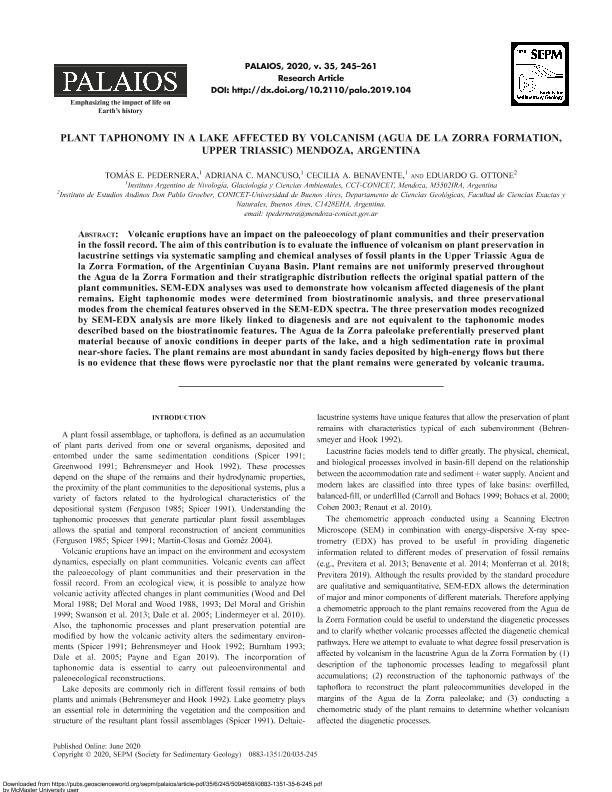Artículo
Plant taphonomy in a lake affected by volcanism (Agua de la Zorra formation, Upper Triassic) Mendoza, Argentina
Pedernera, Tomas Ezequiel ; Mancuso, Adriana Cecilia
; Mancuso, Adriana Cecilia ; Benavente, Cecilia Andrea
; Benavente, Cecilia Andrea ; Ottone, Eduardo Guillermo
; Ottone, Eduardo Guillermo
 ; Mancuso, Adriana Cecilia
; Mancuso, Adriana Cecilia ; Benavente, Cecilia Andrea
; Benavente, Cecilia Andrea ; Ottone, Eduardo Guillermo
; Ottone, Eduardo Guillermo
Fecha de publicación:
07/2020
Editorial:
Society for Sedimentary Geology
Revista:
Palaios
ISSN:
0883-1351
Idioma:
Inglés
Tipo de recurso:
Artículo publicado
Clasificación temática:
Resumen
Volcanic eruptions have an impact on the paleoecology of plant communities and their preservation in the fossil record. The aim of this contribution is to evaluate the influence of volcanism on plant preservation in lacustrine settings via systematic sampling and chemical analyses of fossil plants in the Upper Triassic Agua de la Zorra Formation, of the Argentinian Cuyana Basin. Plant remains are not uniformly preserved throughout the Agua de la Zorra Formation and their stratigraphic distribution reflects the original spatial pattern of the plant communities. SEM-EDX analyses was used to demonstrate how volcanism affected diagenesis of the plant remains. Eight taphonomic modes were determined from biostratinomic analysis, and three preservational modes from the chemical features observed in the SEM-EDX spectra. The three preservation modes recognized by SEM-EDX analysis are more likely linked to diagenesis and are not equivalent to the taphonomic modes described based on the biostratinomic features. The Agua de la Zorra paleolake preferentially preserved plant material because of anoxic conditions in deeper parts of the lake, and a high sedimentation rate in proximal near-shore facies. The plant remains are most abundant in sandy facies deposited by high-energy flows but there is no evidence that these flows were pyroclastic nor that the plant remains were generated by volcanic trauma.
Palabras clave:
Taphonomy
,
Plant
,
Volcanism
,
Preservation
Archivos asociados
Licencia
Identificadores
Colecciones
Articulos(IANIGLA)
Articulos de INST. ARG. DE NIVOLOGIA, GLACIOLOGIA Y CS. AMBIENT
Articulos de INST. ARG. DE NIVOLOGIA, GLACIOLOGIA Y CS. AMBIENT
Articulos(IDEAN)
Articulos de INSTITUTO DE ESTUDIOS ANDINOS "DON PABLO GROEBER"
Articulos de INSTITUTO DE ESTUDIOS ANDINOS "DON PABLO GROEBER"
Citación
Pedernera, Tomas Ezequiel; Mancuso, Adriana Cecilia; Benavente, Cecilia Andrea; Ottone, Eduardo Guillermo; Plant taphonomy in a lake affected by volcanism (Agua de la Zorra formation, Upper Triassic) Mendoza, Argentina; Society for Sedimentary Geology; Palaios; 35; 6; 7-2020; 245-261
Compartir
Altmétricas



